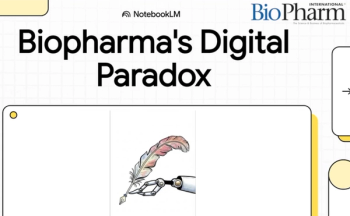
- BioPharm International-11-01-2020
- Volume 33
- Issue 11
Complex Manufacturing Processes Prompt New Inspection Methods
Complex manufacturing processes pose challenges for final product inspection needed to ensure product integrity at commercial launch.
All biologics entering the global pharmaceuticals market are required to undergo good manufacturing practice (GMP)-compliant testing on final product packages to show that the product meets regulatory guidelines. Having appropriate methods to inspect final product to ensure compliance can be challenging as manufacturing processes, fill/finish, and packaging operations evolve with the emergence of new biologics. Final product inspection methods must also adapt.
FDA’s guidance for the inspection of biological drug products (1) includes guidelines on how to establish a system to inspect packaging and labeling of biologic drugs, which should include the measures and activities used to control packaging and labeling. The guidance emphasizes that inspectional coverage should include review of the firm’s “written procedures regarding packaging and labeling controls, for example, procedures that are in place to prevent label mix-ups, document appropriate label storage, and issuance and destruction of labels after use as well as removal of labels from a manufacturing area” (1).
According to the guidance, agency inspectors are tasked with observing a firm’s protocol for examining labels, usage, label storage, and issuance. FDA recommends that drug firms maintain clean and orderly facilities to support the inspection system. Facility size must be suitable, and the firm must ensure that adequate cleaning, maintenance, and operations are upheld. FDA also states in its guidance that the audit of this system “should include a determination of significant physical and/or manufacturing changes” and should include “review of procedures and records of calibration and maintenance, verification that the firm is following procedures and that the procedures conform to the manufacturer’s recommendations and/or user manuals” (1). Finally, audit of the inspection system must also verify that equipment in the facility has been qualified for its intended use and, where applicable, note where any new equipment has been added or existing equipment has been modified since the last inspection.
Complex manufacturing
“Manufacturing processes for new biotherapeutics are very complex,” says Andrew Bulpin, head of Process Solutions, MilliporeSigma. These increasingly complex biotherapeutics require sophisticated production, control, and regulatory processes to ensure that safety, quality, and efficacy parameters are achieved. Bulpin also notes that cell-based manufacturing systems can give rise to inherent product variability.
“It is well established that small changes in the manufacturing process can affect the quality attributes of the final biological products, with respect to their structure, function, and impurity levels, thus, highly sensitive and precise methodologies are needed to ensure quality attributes are maintained prior to product release,” he states.
During the development of the product, for instance, biosafety and quality are built into the full product lifecycle. This process involves control of raw materials used in production, cell substrate evaluation, and drug substance/product testing. “Final product testing generates data to confirm the capability of the manufacturing process to generate product with consistent quality attributes,” says Bulpin.
Key parameters and inspection methods
“The primary aim of product final testing as required by global regulatory authorities is to ensure that the pre-determined specifications for quality attributes that have been shown to be critical for the drug to meet the necessary safety, purity, and efficacy profiles, are maintained,” explains Bulpin. There is thus an expectation that the final package that has been tested will have been examined for possible impurities or contaminants with the use of assays and methodologies that have been demonstrated to be fit for purpose.
The most common inspection method for final biologic product packages is visual inspection, which ensures consistent quality of the product in terms of physical, chemical, biological, or microbiological properties, notes Bulpin. He further points out that, in accordance with regulatory guidance, visual packaging inspection of aseptic filled drugs should be performed at a period to allow growth of any potential contaminating micro-organisms.
“All physical, chemical, biological, or microbiological properties or characteristics should be within appropriate limits, ranges, or desired product quality (International Council for Harmonization of Technical Requirements for Pharmaceuticals for Human Use (ICH) Q8 [2]). Stability methods should also be considered to ensure that shelf life and temperature storage are appropriate,” Bulpin further emphasizes.
Drug companies manufacturing these complex biotherapeutic products face the particular challenge of establishing a well-controlled manufacturing process that generates consistent data (i.e., quality by design, follows ICH Q8 guidelines). “There may be a need for custom assays to address very specific product attributes and hence significant investment in analytical method development to ensure methods are tailored to the product,” Bulpin says, adding that “in particular, biopotency can be a challenge.” Another challenge for service providers and manufacturers is that there is not “one assay” that fits all circumstances, he notes.
Increased automation
Using automation technology and information technology (IT) as tools in the inspection process can help to address some challenges in final product inspection.
“Final product release of biological drug commercialization raises the potential of introduction and use of automated systems for filling, utilization of closed systems, and use of IT systems to monitor and control the release process. The replacement of manual visual inspection with automated processes has the ability to reduce variation,” says Bulpin, adding that “automated filling processes, fill finish systems, and rapid techniques ensure consistency on quality expectations and meet final fill requirements.”
Moreover, technologies are now being introduced to meet the need for closed fill/finish operation that incorporate single-use fill/finish assemblies. In addition, Bulpin points out, the use of improved and updated technology supports release testing (e.g., rapid microbial detection systems, validation of such technologies, and updated analytical technology).
“There is a significant move away from traditional methods to test products that have limited volumes available for testing (e.g., sterility), and, as noted above, there is need for rapid testing for products with greatly reduced shelf life. Another key is testing in closer proximity to the sites of manufacture (e.g., cell-based therapies),” he says.
Faster analysis
New test methods and technologies can speed analysis, Bulpin observes. “Rapid technologies for the detection of microbial contaminants and physiochemical analysis are being introduced and are well received by regulatory authorities,” he states.
Meanwhile, other technologies in development include methods that can assess many product attributes simultaneously, or multi-attribute methods. Such methods are intended to reduce the time burden for product release as the number of independent assays required to ensure product quality prior to release is minimized, Bulpin explains.
References
1. FDA, “
2. ICH, Q8(R2),
About the author
Feliza Mirasol is the science editor for BioPharm International.
Article Details
BioPharm International
Vol. 33, No. 11
November 2020
Pages: 38–40
Citation
When referring to this article, please cite it as F. Mirasol, “Complex Manufacturing Processes Prompt New Inspection Methods,” BioPharm International 33 (11) 2020.
Articles in this issue
almost 5 years ago
Pinpointing Bioprocess Development Successalmost 5 years ago
Control Strategies for Perfusion Cell Culturealmost 5 years ago
What’s New in Downstream Technologiesalmost 5 years ago
Single-Use Sensors Increase Process Understandingalmost 5 years ago
Complex Modalities Require More Sensitive Adventitious Agent Testingalmost 5 years ago
Digital Strategies for Biopharma Manufacturingalmost 5 years ago
Bioprocess Scale-Up: Getting Smarter, Sooneralmost 5 years ago
COVID-19 Vaccine Distribution Raises Multiple Challengesalmost 5 years ago
Pandemic-fighting Drugs in Shortage, AgainNewsletter
Stay at the forefront of biopharmaceutical innovation—subscribe to BioPharm International for expert insights on drug development, manufacturing, compliance, and more.





